The things that we read are disposable – literally and figuratively. We toss out newspapers and magazines as soon as we’re through with them. Most of us keep only a few, if any, of the books that we’ve enjoyed. We zap or forward electronic information the minute we’ve finished processing it. Even urgent updates on radio or television almost literally go in one ear and out the other. Few if any of these sources seem to have great nutritional value as brain food.
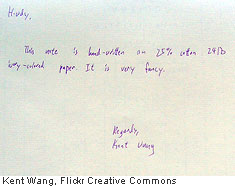 |
| We don’t compose many handwritten letters any more. OK, maybe ones this short! |
Exceptions might be the contents of personal letters we receive from friends and loved ones – if only we received any in this digital age – or information related to our interests, or material that we specifically went looking for.
I call myself “sieve brain” because so many of life’s daily details come to mind and leave without a trace. But I linger over, seem to retain, and enjoy passing along nuggets of knowledge that catch my fancy. I’m a hunter-gatherer of eclectiana – a word I just made up – ever mounting new expeditions, such as my quest for the meaning and origin of “pressing clubs” that I described in the last post.
My e-mail in-box stretches over several screens. My pockets are stuffed with torn and scissored clippings, as well as a pasty mash left by our washing machine as it boils and rubs and chews the notes that I forget were in there. I have bins and boxes full of saved magazines and newspapers and scribbled notes, some of which I’ve been meaning to get to for 25 years.
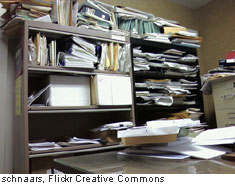 |
| This terrible clutter is not in my office. Mine is much worse! |
I’m starting to worry that I might end up like one of those “hoarders” about whom I wrote for a VOA feature story five years ago. In it, a social worker told me, “We had one situation where our psychiatrist went into a home and climbed on top of a mountain of debris to speak with the client, who was lying in almost like the crater of a volcano, and the psychiatrist’s head was touching the ceiling as he was speaking down to her.”
This could be me and my growing mound of clippings ten years from now. Go away, shrink. Leave me alone!
All of this is a wayward introduction to a series of items that have caught my eye – the kinds of miscellany that, to my way of thinking, deserve a second glance before they’re tossed to the floor of the hamster cage.
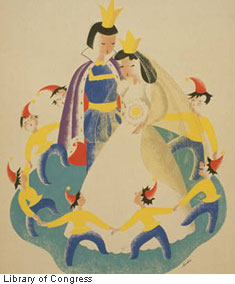 |
| Here’s a poster version of Snow White, her Prince Charming, and seven rather identical dwarfs. In the movie, the dwarfs have distinct looks and personalities |
This is not trivia per se. There’s more to it than naming the capital of North Dakota, or Snow White’s dwarfs, or the words to a 60-year-old toothpaste jingle. I wouldn’t inflict Bismarck; or Dopey, Grumpy, Happy, Bashful, Sleepy, Sneezy, and Doc; or “You’ll wonder where the yellow went when you brush your teeth with Pepsodent” on you. No, indeed.
But I will pass along the following:
 |
| This woman has the right idea: Pack ‘em in! Only the stroller into which my three girls wedged was built for just one rider |
Three of my first wife, Carolyn’s, and my four kids entered the world within 33 months of each other. For a while all of them were in diapers. Having three tightly-bunched little ones gave rise to some imaginative modes of transportation, including Juliette’s careful positioning into the seat of a child stroller, Nicole just ahead of her and halfway in her lap, and Jeannette standing upright on the rear carriage while Carolyn or I pushed the ungainly contraption forward.
Now, come to find out, we may have scarred the girls for life!
You see, they were all facing forward as we rattled through the neighborhood and along the boardwalk at the beach. (Gasp! Oh no! Not that! Heartless parents!)
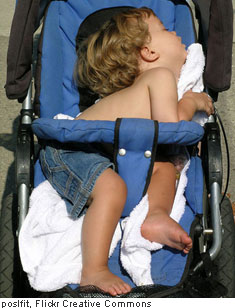 |
| See what happens when kids face forward in their strollers: They pass out from boredom! |
The New York Times just reported on a study of 2,700 families by M. Suzanne Zeedyk, a lecturer in developmental psychology at the University of Dundee in Scotland. She found that caregivers whose babies were positioned facing backward, toward them rather than the street ahead, talked to the little ones more, laughed more, comforted them more, and called lots more things to the little tykes’ attention.
 |
| So we want to make stroller rides more enriching? How about turning the conveyances into miniature carnival rides!? |
Zeedyk found that forward-facing strollers are a relatively recent invention, made necessary by the mechanisms that collapse them for storage. She observed that forward-facing tots grow bored with the scenery, suck their thumbs a lot, and doze off a great deal rather than engaging in constructive dialogue with Mom or Dad or the stroller-pushing babysitter.
Funny, Carolyn and I thought our kids saw and heard enough of us all day and all night, and that glimpses of colorful beach umbrellas or passing bikes and buses might hold more interest than our weary faces.
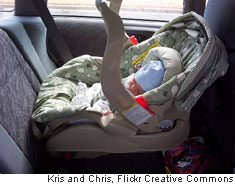 |
| As if we didn’t have enough to worry about with the alignment of strollers, what about car seats? |
As if Zeedyk had not spread enough paranoia, she also encouraged parents to “think again about how babies experience . . . other forms of transportation like car seats, shopping carts, and slings.” Oh, the guilt.
Letter writers to the Times weighed in promptly. One woman endorsed the notion of facing baby toward you, noting, with a snide lash, “At least [rear-facing] children would see their caregivers while they chat on their cellphones.”
Other über-parents pointed out, with smug satisfaction, that they disdain strollers entirely, preferring to hold their offspring to their backs or bosoms in slings at all times. That’s some stimulating view for the wee ones, all right: Mom’s shoulder or the back of Dad’s head.
But another woman wrote to say, “While hundreds of thousands of children face death every day from preventable diseases and starvation, we are now being asked to worry which direction our infant strollers are facing.”
Researcher Zeedyk may have hit upon the perfect compromise, however. She said she’d like to see stroller seats rotate. They could face forward one day and back the next. Who knows? – perhaps Junior could ride facing right on Wednesdays and left every Friday.
Zeedyk could be onto something amazing for toddler development: Why stop with swiveling strollers? Let’s motorize the rotating stroller seats! That way, we could nourish our children’s inquiring minds as we roll along, then reward them with a dizzying spin that would put a carnival’s teacup ride to shame.
A routine police-blotter item in the Washington Post caught my eye. Its headline described the unfortunate deaths of two “senior citizens” in a house fire.
Coined in the 1930s, “senior citizens” is a euphemism for the elderly, old-age pensioners, wizened grayhairs – the most venerable citizens of a community.
The “senior citizens” who tragically died in that house fire were, respectively, 78 and . . . 65!
I’m 66. Feel free to select from the following:
Oldster. Geezer. Feeble and infirm. Doddering.
 |
| You know what they say about “senior citizens”: Our faces have “character.” By the way, this is some other fella. |
Old Goat. Coot. Ready for the Home. Old as the Hills. In the Autumn of My Years.
And my personal favorite: “Sundowner.”
But just a minute there, sonny (or honey): 67 is the new 47!
Isn’t it?
Booze on the Beach
I have retained enough of my faculties to remember Spring Break back in my college years. Way, way back when.
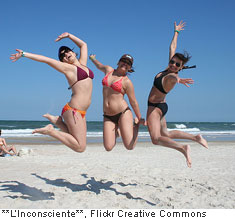 |
| Spring Break is quite a change of pace from studies, especially when one is still seeing snow and sleet outside the classroom window |
I never had the nerve to get raunchy during this interlude between classes, when many of my peers were passing out on half a keg of beer, smoking “reefer” behind the dunes, “mooning” cops and women in string bikinis, “hooking up” with good-looking strangers for casual sex, or, almost without fail, puking from the balcony of the Surf ‘n’ Sand, Sun ‘n’ Surf, Sand ‘n’ Sun, Sun ‘n’ Sand, Sand ‘n’ Surf, or Surf ‘n’ Sun Motel.
 |
| Lovely Fort Lauderdale was turned into one big party for many years until residents and merchants grew tired of the noise and destruction |
This was all considered by many young people and indulgent adults to be youthful “letting off steam” – never mind the fatal falls from those balconies or the highway deaths following drunken binges. Entire cities such as Fort Lauderdale and later Daytona Beach in Florida, and Cancun in Mexico, gained reputations and fortunes from the annual bacchanals. From still-icebound northern states and Canada each March, more than 350,000 young people descended on Fort Lauderdale alone,
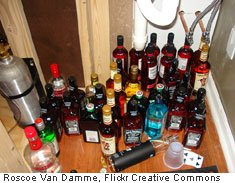 |
| This is not an atypical larder of booze at Spring Break “crash pads,” with one exception. Most of these bottles are full! |
particularly following the release of the scandalous (for its time) “Where the Boys Are” movie in 1960.
But the Florida cities weren’t such fun once open containers of alcohol were banned on the beach, the national minimum drinking age was raised to 21 in 1985, and police cracked down on blotto drinking, public nudity, and wanton vandalism.
So the wildest “action” moved southwestward to Cancun.
Today in places like Panama City on Florida’s Gulf Coast panhandle – where the music-and-videos cable network MTV will be broadcasting Spring Break 2009 live – some hazards confront revelers that did not trouble the “party hardy” set of years gone by:
•Most owners of young, strong bodies still recover well after “getting wasted” on drugs or beer or rum. But reputations don’t heal so quickly when booze-addled behavior is captured on a cell phone camera and posted for all the world – including Mom, Dad, Pastor Bill, and Principal Smith back home – to see.
•The U.S. State Department has issued a travel alert warning citizens about increased violence, including rampant kidnapping for ransom, in sunny Mexico.
•The threat of AIDS can dampen enthusiasm for indiscriminate sex.
This year’s message, though you won’t see it streaming behind one of those single-engine biplanes puttering above the surf: Blitzed-out-of-your-mind “rites of passage” can lead to rites of a different kind.
Last ones.
I was raised a lukewarm Lutheran in Lakewood, Ohio. Most of my playmates were Roman Catholic. My mother was wary of them, fearing that they might “convert” me and expose me to strange rituals.
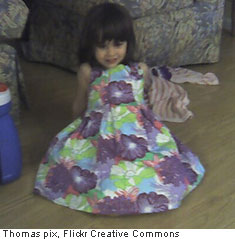 |
| Little ones know that Easter morning is special when their parents lay out bright new outfits for them to wear |
But I watched them with interest, especially at this time of year, when the boys would fit into scratchy suits and ties, and the girls into pretty dresses for holy days such as Ash Wednesday, Good Friday and Easter Sunday. For devout Catholics, especially, the 40 days of Lent leading up to the day that, Christians believe, Christ arose from the dead were serious dress-up times.
 |
| Easter has two radically different components. It is the holiest day of the year for Christians, but also one of the most delightful secular celebrations of Spring for kids and their parents |
Young Lutherans also learned about Holy Week and Christ’s Resurrection, though with less solemnity. Thanks to Mother’s robust bangs on our upright piano, I knew all the secular lyrics of the season, such as “In your Easter bonnet, with all the frills upon it”; and “Here comes Peter Cottontail/ hoppin’ down the bunny trail/ hippety-hoppity, Easter’s on its way!”
Mother, Grandmother, and I paid considerable attention to Easter bunnies, chocolate eggs and rabbits, and the search for colored hard-boiled eggs. We’d dye them the night before Easter – I can still smell the vinegar boil – and then the “bunny” would hide them overnight, and not always in obvious places. Sure, the lump in the sofa cushion was always a giveaway, but what manner of bunny would put a purple egg in my mother’s spring-driven ashtray? Gross!
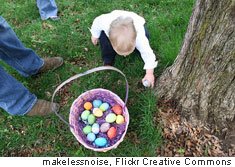 |
| What a haul! |
Grandmother would keep careful count of the eggs as they were gathered, but knowing the correct number was not enough. Many were the years that one or two eggs were discovered two or three weeks later in places like my dog Taffy’s fluffy bed, only by dint of their rotten smell.
One year, Mother allowed me to buy an actual bunny. I don’t, or perhaps don’t care to, recall what became of it. In an early precursor of later creativity, I probably named it “Hoppy” or “Thumper.” Taffy may have called it “lunch.”
All in all this time of year, it seemed like my Protestant buddies and I were having way more fun than my Catholic friends, whose noses seemed to be forever stuck in their Catechism books. Worst of all for them, they were expected to abstain from something for Lent – often meat. This, they explained to me, was supposed to help them relate, ever so minimally, to Christ’s suffering on the cross.
 |
| Give this up for Lent? Not on your life! |
The very thought of abstaining from a Manners Big Boy triple hamburger with special sauce seemed inhumane to me. We Protestants tried to give up something, too – less likely food than some pleasurable activity like watching the Cleveland Indians baseball team on TV. This lasted about a week – less if we heard on the radio that the Indians were rallying late in a game.
Of late, Lenten sacrifice has taken some unusual turns. In a development that fits our times, the Religion News Service recently reported that growing numbers of young “Christian technophiles” have resolved to give up Facebook, My Space, Twitter, and other online social networks for Lent. “Religious leaders and scholars across the country are encouraging the faithful to unplug from such sites in a virtual Lenten fast,” the news service’s Kelly Huyboer noted.
I wish I had known of this trend earlier. I’d have slipped a copy of Huyboer’s article under the doors of my colleagues and friends. No doubt, though, they’d sooner give up steak than texting or tweeting for 40 days.
Tick, Tock, Debtors’ Clock
From time to time and certainly now, America’s ever-growing national debt has been an ominous concern. Where we once thought of this astronomical, ever-rising figure as a gossamer bookkeeping contrivance of little actual consequence, we now wonder about the day when the trillions of dollars in I.O.U.’s will come due. It is not the legacy we had hoped to leave to our children or theirs.
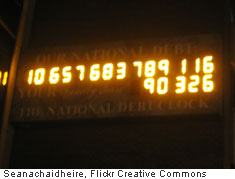 |
| This photo briefly stopped time, but not the ever-rising national debt figure on the clock in New York City. The number below the long one is the average American family’s share of that debt |
The national debt was once an obsession with New York real estate developer Seymour Durst, so much so that in 1989 he ordered a national debt clock installed on company property, one block from Times Square in Manhattan. The federal debt at the time was approximately $2.7 trillion, and from the moment the electric clock was activated, the reading clicked upward every second of every day.
More accurately, it rampaged ahead every second rather that ticked.
On the digital display, that 1989 debt figure looked something like this: $2,700,000,000,000, with numbers other than zeroes filling in the last 11 digits. The clock could handle a figure up to the unimaginable $9,999,999,999,999 – more than three times the reading when it started.
Shockingly, from 2000 to 2002 U.S. debt actually fell as the nation achieved three straight surpluses. The Durst Organization had to turn the clock off during that time, waiting for rampant debt to begin again. It did, of course, reaching the number displayed on the clock and on and on beyond it.
You can probably guess what happened this past October: The national debt passed the $10-trillion mark. But Durst’s clock had no digits left to incorporate that once-inconceivable figure. So the clock keepers simply replaced the dollar sign in front of the debt figure with a “1” and kept right on racking up higher numbers in the remaining 12 spaces.
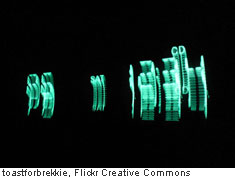 |
| The soaring national debt is a blur, all right |
A permanent new clock with a built-in extra digit is planned. It’s certainly needed, since, as of this writing, the federal debt has shot past $11 trillion. In the past three minutes alone, the debt rose more than $17 million! And during the government’s current, deliberate economic stimulus spending spree, the figure won’t be going down any time soon.
To update the late U.S. Senator Everett Dirksen’s statement more than 50 years ago, when he was talking in millions: “A trillion here and a trillion there, and pretty soon you’re talking serious money!”
Geraldo from Brazil Has Another Thought
Ted, will you please tell us why you use meters, kilometers etc., when we all know that Americans don’t even know how to turn centimeters into inches? Also, what we call football in the rest of the world is soccer in the United States. Does that mean your blog is primarily intended to foreign readers? If so, why do you use such uncommon words in your postings? Not that I don’t like it – I’ve improved my vocabulary tremendously since I started reading you – but in this case you should write a lot more Wild Words at the end of each posting.
Geraldo, since I write for the Voice of America, which is rarely heard in the United States except on the Internet and powerful shortwave receivers, I go with international measurement conventions. Maybe it will prompt a few Americans who happen upon the blog to bone up on such things. As for “uncommon words,” I write in full American English, recognizing that some words will be a challenge. Hence the “Wild Words.” I trust that those not appearing there will make some sense in context. The archive of Wild Words is growing and growing, and since most posts are already running longer than I’d like them to, I don’t want Wild Words to stretch on for page after page. VOA also broadcasts in “Special English,” aimed at English learners, using an extremely limited vocabulary of about 1,500 words. This is harder than it sounds, and it’s not what I do. I hope you and others will fight your way through my thicket of words and stay with me!
(These are a few of the words from this posting that you may not know. Each time, I’ll tell you a little about them and also place them into a cumulative archive of “Ted’s Wild Words” in the right-hand column of the home page. Just click on it there, and if there’s another word in today’s blog that you’d like me to explain, just ask!)
Doddering. Feeble, even senile. The word is often combined with others, as in “you doddering old fool.”
Gossamer. As the noun, the word literally describes a fluttery film of cobwebs. More often, the adjective form describes a delicate, feather-light, even dreamy scene.
Per se. From the Latin, meaning intrinsically, exactly. “It wasn’t fraud per se, but it had all the elements of it.”
Raunchy. Crude, uncouth, vulgar. So-called “dirty” jokes are often raunchy, even obscene by civil standards.
Snide. Sarcastic, in a snotty sort of way. Snide comments are often asides about someone else’s perceived inappropriate appearance or behavior.








